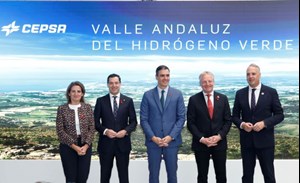News
Cepsa to invest €3 B in Andalusia to build the largest green H2 hub in Europe
Cepsa will invest more than €3 B to establish the Andalusian Green Hydrogen Valley, creating the largest green H2 hub in Europe in southern Spain. The project, part of Cepsa’s 2030 strategy Positive Motion, will contribute to Europe's energy security and independence, in line with the objectives of the European Union's REPowerEU strategy. The investment is the biggest milestone to date of Cepsa's Positive Motion energy transition plan to lead sustainable mobility and the production of green H2 and advanced biofuels in Spain and Portugal this decade.
The company will build two plants with a total capacity of 2 GW to produce green H2. The plants, with 1 GW of capacity each, will be in Palos de la Frontera (Huelva) next to Cepsa’s La Rábida Energy Park and at the company’s San Roque Energy Park in Cádiz. The Huelva plant will start up in 2026, reaching full capacity in 2028, while the Cádiz facility will be operational in 2027. Cepsa is already working on the engineering and administrative processing of the project.
To generate the renewable electricity needed to feed production of green H2, Cepsa will develop a 3-GW portfolio of wind and solar energy projects with an additional €2 B investment. The company will also collaborate with other renewable energy producers in Andalusia and the rest of Spain to promote the integration of these new plants into the electricity system.
During the presentation of this hub, held this morning at the San Roque Energy Park, Spanish Prime Minister Pedro Sanchez, said, “This investment will help Spain achieve its goal to become an energy exporting country, with the first European green hydrogen corridor between the Campo de Gibraltar and the Dutch Port of Rotterdam. Andalusia has everything it takes to become one of the most competitive regions in the world for hydrogen production.”
Juan Manuel Moreno Bonilla, President of the Regional Government of Andalusia, said, “We are talking about the great energy source of the future, which can decarbonize industry, mobility, and households. Andalusia has the position and strength to lead in the generation and export of green hydrogen, and public-private collaboration can strengthen our position in the production of this clean energy vector. That is why we are setting up an Andalusian Green Hydrogen Alliance in which the Administration and all interested parties will participate."
“The Andalusian Green Hydrogen Valley is a groundbreaking project whose 2 GW capacity is 10 times bigger than the largest under construction in Europe today. This project produces green hydrogen at scale that can decarbonize industry, aviation, and heavy road and maritime transport in Europe, for Europe,” Maarten Wetselaar - CEO of Cepsa.
Juan Carlos Ruiz Boix, mayor of San Roque, Roel Nieuwenkamp, ambassador of the Netherlands in Spain, Gerardo Landaluce and Pilar Miranda, presidents of the Ports of Algeciras and Huelva, and Nico Van Dooren, director of new business at the Port of Rotterdam, also participated in the event alongside other authorities and energy sector representatives.
The Andalusian Green Hydrogen Valley will produce 300,000 tpy of green H2, driving the decarbonization of Cepsa’s Energy Parks where it will produce advanced biofuels for aviation, and maritime and heavy land transport. H2 will be particularly important to produce by-products such as green ammonia and methanol, which will ensure that green marine fuels will be available in the main Spanish ports, helping to decarbonize maritime sector customers.
Implementing this project will save 6MMtpy of CO2 emissions. Aside from replacing grey H2 in industrial processes, green H2 will also have a multiplier effect when used in the production of renewable fuels that will replace traditional fossil fuels.


